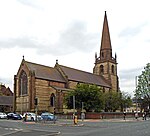Tuebrook and Stoneycroft (ward)
Use British English from March 2015Wards of Liverpool
Tuebrook and Stoneycroft is a sub-urban Liverpool City Council Ward within the Liverpool West Derby Parliamentary constituency. It contains the Tuebrook and Stoneycroft areas of Liverpool. The population of this ward at the 2011 census was 16,489. In 2004 it was reformed taking in small parts of the former Old Swan, Clubmoor, Croxteth and Anfield wards, and losing small areas elsewhere. The ward elects 3 councillors.
Excerpt from the Wikipedia article Tuebrook and Stoneycroft (ward) (License: CC BY-SA 3.0, Authors).Tuebrook and Stoneycroft (ward)
Gardner Road, Liverpool Stoneycroft
Geographical coordinates (GPS) Address Nearby Places Show on map
Geographical coordinates (GPS)
| Latitude | Longitude |
|---|---|
| N 53.425 ° | E -2.928 ° |
Address
Gardner Road
Gardner Road
L13 7EE Liverpool, Stoneycroft
England, United Kingdom
Open on Google Maps







